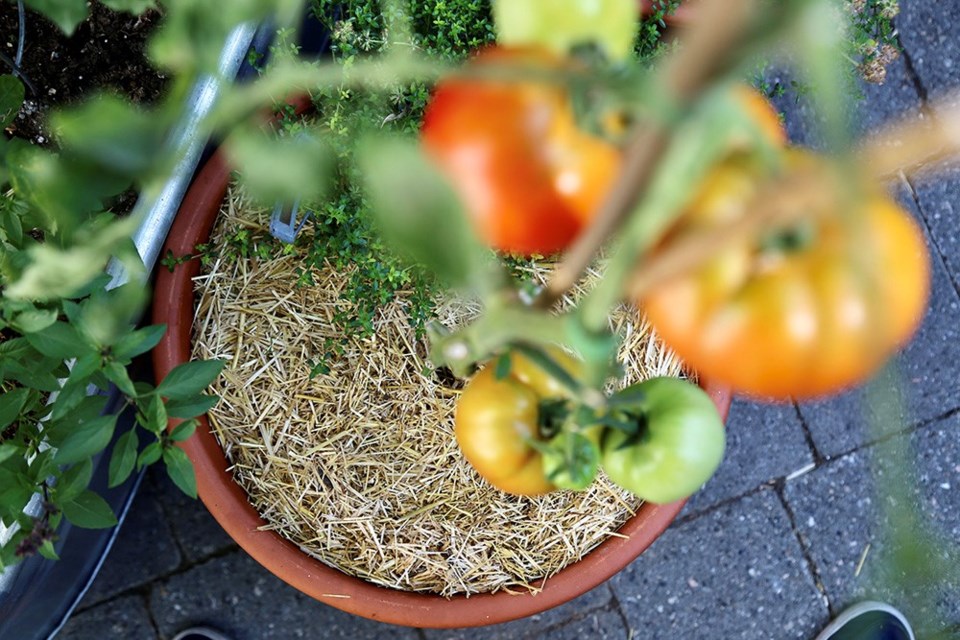With several extraordinarily hot days in the forecast, there are a few things we can do to protect the investments of time and money we have made in our food gardens.
We have been through this already this year, and learned from it. I have learned to lean more heavily on stacked planting, triple-thick mulching, seeding latent bed space, and converting non-productive gardens to edible ecosystems. Also, I am noticing how much so-called “free” water there is for the saving — literally.
Barely one month ago, our garden was properly singed in places that I simply could not protect with existing systems. Since then I’ve made some changes. Some small and simple, other larger and operational.
Small but meaningful changes include a stacked planting of fall beets under bush beans to leverage built-in shade to protect and stall the beets while the beans go hard in the heat, and several portable semi-shade-chasing container plantings of root vegetables sown in shallow trenches under several centimetres of clean straw mulch. Potted tomatoes too, were triple mulched. I moved the thirsty celery plants entirely, from direct sun, to the semi-shade of a mini kale forest.
Existing bare soil edging along our alyssum-mulched berry patch, the trellis paths, and boxwood hedge borders were called into service for carrots, parsnips, strawberries and peppers. Those areas are watered anyway and offer elements of built-in partial shade, so why not maximize latent space?
Three sisters
We’ve been celebrating the ancient, resource-efficient wisdom of our ‘three sisters’ companion planting of corn, pole beans, and squash — a very wise First Nations of The Americas tradition of family planting corn trellises for nitrogen-fixing beans, together with ground-mulching/insect-repelling/shade-providing squash. Not a sun-scald or wilted leaf in the entire bed, and it endured full-on sun and heat during the last wave.
Permanent operational changes include the installation of the first two of four rain barrels, strategically placed near all-season food and nursery gardens, and the conversion of a small grassy area, to a complex edible ecosystem and food forest.
The rain barrels, made from second-hand oak wine casks, are beautiful and highly efficient, providing impressive gravity-fed pressure, and large storage capacity at 250 litres per unit. Overflow feeds back into the downspout at ground level. We live in a rancher, with a large roof and deep overhangs, so according to my calculations, we are directing some 900,000 litres of rainwater annually, into our downspouts. Crazy right? Harnessing 1000 litres at any given time among four rain barrels is a drop in the bucket of urban permaculture possibilities. A below-ground rainwater cistern to power all irrigation sounds like a very good idea; one we are considering.
Odds and sods
The conversion of the small lawn area to food forest was, admittedly, a dramatic but therapeutic reaction to then overall devastation caused by the initial heatwave. The doing of it was intense, laborious and productive garden therapy, utilizing upturned sod and a born-of-necessity combination of lasagna layering and hügelkultur.
Odds and sods of orphan berries, runt vegetables, pollinator-friendly flowers, and a potted persimmon tree were planted into organic composted soil, over straw and brown cardboard, over a whole mess of buried magnolia branches and green garden biomass. A delicious and highly nutritious mess that is already proving fruitful. The in-place irrigation, once relegated to lawn and laurel hedge duty, is now righteous in its oversight of dozens and dozens of food plants.
It is hard to know if the odd assortment of late-planted squash and watermelon will ripen by season’s end, but it really doesn’t matter. The plants are doing important work now in contributing structure and biology to the soil, and begin building a critical below-ground mycelial network and community of microorganisms, to help transport nutrients from the decaying fill to future generations of food and pollinator-friendly plants.
If you have the time and space this summer or fall, consider converting a patch of grass to a beautiful edible ecosystem. In the interim — mulch, mulch, and mulch some more — and perhaps, install a rain barrel.
Laura Marie Neubert is a West Vancouver-based urban permaculture designer. Follow her on Instagram @upfrontandbeautiful, learn more about permaculture by visiting her Upfront & Beautiful website or email your questions to her here.
For a taste of permaculture, click on the YouTube link below:





